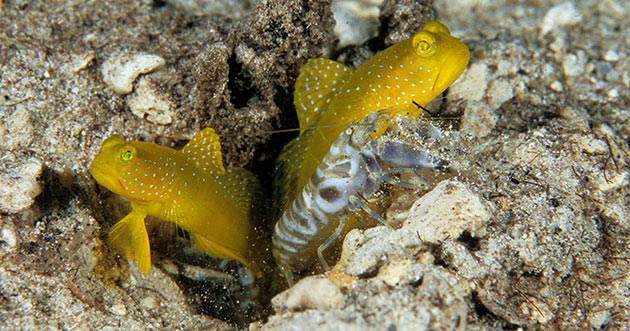
Captive Care
The Shrimpgobies (family Gobiidae) are easy to keep. Their relatively small sizes and less active lifestyles mean you can keep them in aquarium as small as 30 gallons. In fact, the smaller species will be happy as a “pig in mud” in an aquarium as small as 10 gallons. One prerequisite for the Shrimpgoby aquarium is a cover of some kind. While glass covers were once popular, most hobbyists now try and stay away from them because they inhibit gas exchange at the water’s surface. Covers constructed out of egg crate material, fiberglass screen and PVC are used by many reef aquarists. A cover like this will keep the Gobies in and let the carbon dioxide out.
Be aware that these fish are able to find and jump through relatively small openings in the aquarium top. They are most likely to perform these suicidal aerial displays when they are initially introduced to the aquarium, if they are pestered by other aquarium inhabitants, or when the aquarium lights are suddenly turned off. A small night light mounted over the aquarium may prevent them from trying to bail when the lights are extinguished. These Gobies have been known to leap into overflow boxes as well.
The best way to set up your Goby-Shrimp aquarium is with an external filter and live substrate. An outside filter can be used to provide mechanical and some chemical filtration, while a layer of live sand and some live rock can be employed for biological filtration. Your Snapping Shrimp will help keep the sand stirred and detritus into suspension. In fact, I had a setup with thick aragonite substrate and two large Snapping Shrimp that kept sediment suspended in the water column almost constantly. The aqaurium had been set up for a long time and had accumulated a significant amount of sediment and detritus, which the Shrimp were effective at disturbing. Some aquarists might find turbid aquarium conditions like this annoying. But as time past, and more of the sediment was removed by mechanical filters, the water became clearer.

Amblyeleotris randalli |
Snapping Shrimp and Shrimpgobies will do well in reef aquariums with a thick sand substrate. Keep in mind, it is possible for rock work to become unstable and collapse in a reef tank, or any aquarium for that matter with décor, when the Shrimp excavates underneath it. Therefore, make sure you place the rock work on the bottom panel of aquarium glass and place the sand substrate around the rock, rather than placing the sand on the aquarium bottom and putting the rock on the sand.
When it comes to selecting substrate, it is important to include a finer grade of sand. Studies have shown that Snapping Shrimp will be more reclusive, spending more time in their burrows if the burrow construction does not occasionally fall in and elicit maintenance behavior. Avoid exclusive use of oyster shell, coral rubble or other larger grades of substrate as burrow construction will be too stable. However, be sure to mix some pieces of coral rubble, small pieces of live rock and/or medium-sized shells with the sand so that burrow construction isn’t impossible. (To get a better idea of what types of material you should place on the aquarium bottom to facilitate burrow construction pay special attention to the photos accompanying this article.) A few flat pieces of live rock laying on the bottom will also provide a roof for the shrimp's burrow. I would place a layer of substrate 3 to 5 inches deep on the aquarium bottom.
If you want to enhance the color of your Shrimpgobies, try using black volcanic sand. On the darker substrate, the colors of many of the Shrimpgobies (and some other gobies as well) will be intensified. This phenomenon can also be observed in nature. For example, if you dive along the shores of Bali, Indonesia, where the sand is black, the Gobies are radiant!
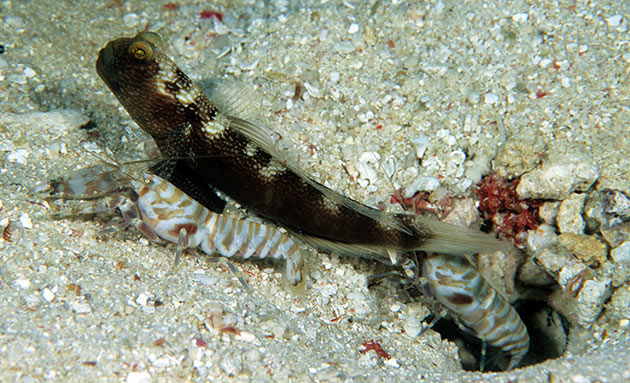
Cryptocentrus fasciatus |
Some species of the Snapping Shrimp and Shrimpgobies are particular about who they hang around with. The degree to which they maintain this species specificity in the aquarium has not been fully investigated. But I have seen species of Shrimpgobies and Snapping Shrimp associate together in the aquarium that usually do not do so in the wild. It would seem logical that if you are trying to form a Goby-Shrimp relationship in your aquarium you will have a greater chance of success with a Goby species with a more eclectic taste in Shrimp (i.e., a Goby that associates with a larger number of shrimp species in the wild). Some marine fish wholesalers actually sell Snapping Shrimp-Goby pairs. By buying a pair that was collected together, you can be almost guaranteed that you’re getting two animals that will associate together in your aquarium.
Another important thing to remember is that not all Snapping Shrimp species live with Gobies. For example, most species from the Atlantic and Caribbean are unsuitable as Goby partners. The exception is the Florida Snapping Shrimp (Alpheus floridianus), which associates with the Atlantic Orangespotted Shrimpgoby (Nes longus) and the Spotfin Goby (Gobionellus stigmalophius). This Shrimp is gray overall with some faint bands on the claws and several thin brown lines on the abdomen.
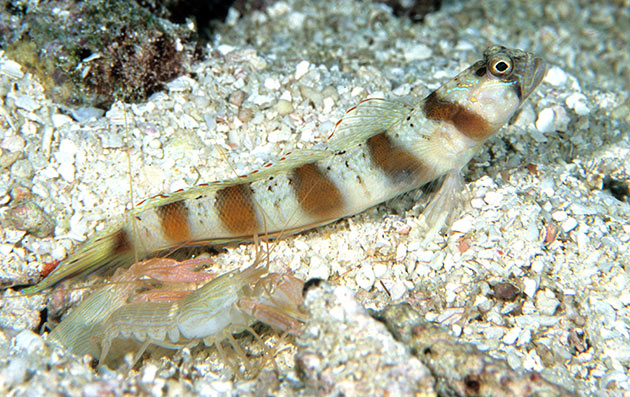
Amblyeleotris rubromarginatus |
Fortunately for the aquarist, Shrimpgobies are fairly disease resistant. In fact, they are more likely to succumb to tankmate bullies than parasites. Some of the smaller Shrimpgobies may be abused by aggressive tankmates, like Dottybacks, Pygmy Angelfishes, Damselfishes, Surgeonfishes and Hawkfishes. When kept with more pugnacious fishes, these Gobies tend to hide and may starve to death.
Care must be taken when placing Shrimpgobies together, especially conspecifics (i.e., members of the same species). It is best to place them in the aquarium simultaneously and to purchase known pairs if buying individuals of the same species. In the wild, the distance between individuals varies from one species to the next. For example, in one study Wheeler's Shrimpgobies were usually found about 5 feet apart, while Steinitz's Shrimpgobies (Amblyeleotris steinitzi) were typically only 2 feet apart. In another study, it was reported that the burrows of A. steinitzi were a minimum of 14 inches apart. Not surprisingly, larger gobies prefer burrows with larger openings. This information can be used in the aquarist's favor if he or she wants to keep more than one individual in a system. Just construct different sized artificial burrows and purchase Shrimpgobies of varying sizes. The smaller Goby (or Gobies) will stick to the smaller burrows and the larger Goby (or Gobies) will occupy the larger ones. If you choose to employ this tactic, add the small Shrimpgobies to the aquarium before a larger individual(s).
Aggressive encounters between Shrimpgobies of the same species regularly occur in the wild and in the aquarium. In the wild, some species will stray up to 10 feet from their "home" burrow, which will cause neighboring conspecifics to display and try and drive them from their territories. Several different aggressive behaviors have been observed in Shrimpgobies. This includes chasing, lateral displays and circling. Chasing is when one fish swims after another to evict it from its territory. The lateral display is an impressive behavior and is used to intimidate an intruder and scare it from the area. The displaying individual will move towards its opponent with its fins raised, it mouth and gill covers spread open and its body undulating. The intruding Goby, especially if it is larger, may respond with a similar display – this may lead to circling behavior. This is when the pair circles, in head to tail orientation, each trying to bite the other's tail region. While Goby fights in the aquarium often result only in torn fins, subordinate individuals may end up hiding, not feeding or succumbing to disease.
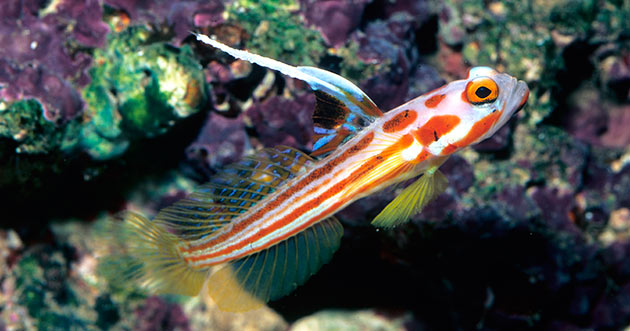
Stonogobiops yasha |
Both the Gobies and their Shrimp associates will feed on a wide variety of fresh, frozen and flake foods. One of the best ways of meeting the Goby's long-term nutritional needs is to vary the diet. If you have a finicky Goby (these are rare), try dropping a few black worms near its hiding place. They usually cannot resist this wiggling delicacy. In the wild, these Gobies feed mainly on small crustaceans that live on the substrate near the burrow entrance and planktonic crustaceans that drift past. Unlike some of other family members (e.g., Signigobius biocellatus, Valenciennea spp.), the Shrimpgobies are not effective substrate sifters. While they will occasionally ingest sediment to feed on infaunal organisms, they do not engage in aggressive sifting like certain other Goby species.
If you are as enthusiastic about this family of fishes as I am, you may want to set up a system only for Gobies. Because most Gobies do not occupy the upper parts of the aquarium, a low aquarium with more horizontal surface area for living space is preferable to a taller one. 20 Long and 30 gallon aquariums are ideal Goby aquariums. I would recommend stocking a 30 gallon aquarium with two Shrimpgobies of the genus Amblyeleotris or a pair of Cryptocentrus spp. and several Dartfish, Ptereleotris spp. (which are placed in the family Microdesmidae by most ichthyologists).
Creating Burrows for Shrimpgobies
If you cannot provide adequate building materials for your Shrimp and Goby, or if you want to habituate them to a particular part of the aquarium, you could always construct an artificial burrow. I use PVC pipe, elbows, and caps to construct these synthetic domiciles. The pipe can be cut at varying lengths, depending on the size of the aquarium and the Goby it is meant to accommodate, but a 6 to 8 inch pipe is adequate for most species. A number of small holes (1/4 inch in diameter or larger depending on the substrate used) should be drilled in the pipe to allow fresh water to circulate through the burrow and some sand to flow in. The elbow can either be angled at 45° or 90°, but I recommend the former because it allows more debris to collect in the pipe, which will keep the Shrimp busier and permit better viewing of the pair. The other end of the tube should be capped off with the appropriate PVC fitting, but I would not glue any of the fittings in place so that you can more easily remove a Goby if necessary or clean the tube. The tube can be buried under gravel, rocks, or rubble and small pieces of coral rubble can be placed around the open end to give the burrow a more natural appearance. If you want to create an even more elaborate burrow try placing an elbow on each end, so there are two entrances, or purchase a three- or four-way PVC connector, more straight lengths of PVC and PVC elbows and construct a complex burrow system with multiple chambers and openings.
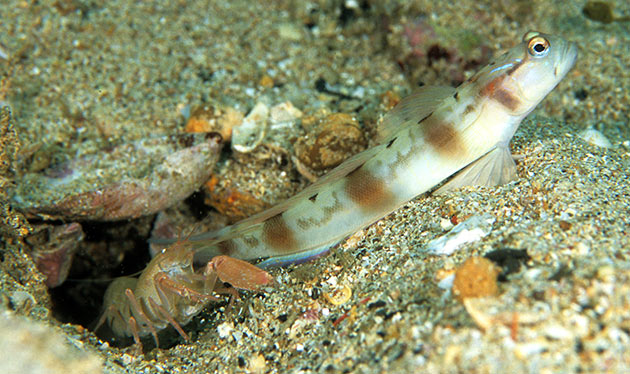
Amblyeleotris gymnocephala |
In an aquarium with thick substrate, an artificial burrow made of clear plastic tubing can be placed near the front glass so that you can view the subterranean activity of its residents. Take a piece of large diameter flexible tubing and cut it in half along the axis. Drill holes in it and cap one end. Then place the sliced side up against the glass, either the front or side, and angle it so the capped end reaches the aquarium bottom and the opening is just above the substrate. I recommend placing a piece of black acrylic in front of the burrow, which should be removed only when the room lights are extinguished; this will reduce the amount of disturbance due to activity around the aquarium, which could cause the pair to vacate their new home. If you have trouble viewing the activity of the burrow residents due to lack of light, mount a red incandescent bulb in front of the aquarium to illuminate the chamber.
The best way to introduce the pair to an artificial burrow is to put the Shrimp in a soft net or a jar and place it over the entrance. After the Shrimp enters the hole repeat this procedure with the Goby.
By the way, these artificial burrows work great for Jawfishes, Firefishes, Dart Gobies, Wrasses, Dottybacks and many other fish that refuge in burrows or small holes in the wild. And for you retailers that have substrate in your aquariums, they can make catching fish that frequently use them a snap! Just place your hand over the burrow opening, lift it to the surface and gently pour the resident fish in a bag of water.
Part 1:
Shrimpgoby and Snapping Shrimp Symbiosis |
| |
Part 2:
Captive Care of Shrimpgoby and Snapping Shrimp |

Scott Michael
Scott W. Michael is an internationally-recognized writer, underwater photographer, and marine biology researcher specializing in reef fishes, and was the Banquet Speaker at our 2007 and 2008 Coral Conference and Frag Swap. He is a regular contributor to Aquarium Fish Magazine, Freshwater and Marine Aquarium Magazine, SeaScope, and is the author of Reef Fishes Vol 1, Vol 2, and Vol 3, Vol 4, and Vol 5., A Pocket Expert Guide Marine Fishes, A Pocket Expert Guide to Reef Aquarium Fishes, 101 Best Saltwater Fishes: How to Choose and Keep Hardy, Brilliant, Fascinating Species That Will Thrive in Your Home Aquarium, Reef Sharks & Rays of the World, and Aquarium Sharks & Rays. Having studied marine biology at the University of Nebraska, Scott has served as a scientific consultant for National Geographic Explorer, the Discovery Channel, and French educational television.
|